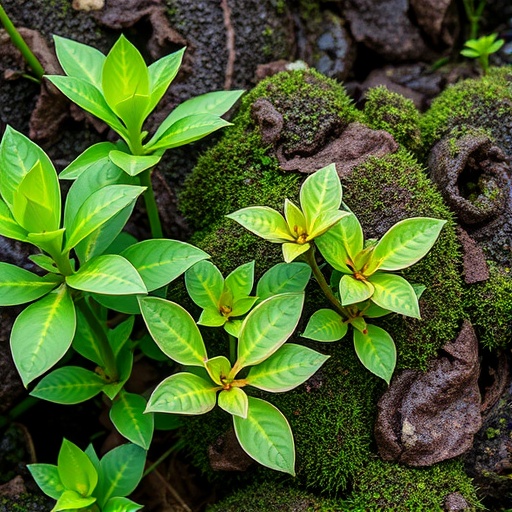In the quest for sustainable environmental solutions, research into plants that can absorb heavy metals has gained significant momentum. Recent studies have indicated that certain species of plants possess a remarkable ability to accumulate mercury, a highly toxic element, from their surroundings. This finding holds substantial promise in the field of phytoremediation, which leverages natural processes to restore polluted environments. The research conducted by Chaverra, Cuervo, and Gutiérrez in northwestern Colombia has shed light on this niche area, highlighting plants that exhibit exceptional mercury accumulation properties.
Mercury pollution is a global concern, largely attributable to industrial activities, mining, and waste disposal practices. Once released into the environment, mercury can transform into methylmercury, an even more toxic compound that enters the food chain through aquatic ecosystems, posing serious health risks to both wildlife and humans. The ability to remediate such contamination effectively is imperative for ecological health and human safety, making the discovery of mercury-accumulating plants particularly relevant.
The intriguing aspect of the researchers’ findings is the identification of specific plant species endemic to northwestern Colombia that can tolerate and accumulate significant levels of mercury. These plants have adapted to thrive in contaminated soils, showcasing a unique biological mechanism that not only allows them to survive in such harsh conditions but also provides potential solutions for bioremediation efforts. The researchers meticulously analyzed the soil and plant samples to quantify the mercury levels and understand the physiological processes involved in accumulation and detoxification.
The study’s implications extend beyond academic interest; they herald a potential shift in remediation strategies employed in contaminated zones. Traditional methods, such as chemical treatments or soil excavation, can be costly and environmentally invasive. The integration of phytoremediation practices utilizing mercury accumulator plants offers a more sustainable, cost-effective, and ecologically sound approach to addressing soil and water contamination. This technique not only aids in cleaning up toxic environments but also promotes biodiversity, as these plants can coexist with local flora and fauna.
Particularly noteworthy among the identified species are those that exhibit hyperaccumulation capabilities. Hyperaccumulators are defined as plants that can absorb and store exceedingly high concentrations of metals within their tissues without suffering from phytotoxicity. This trait is of paramount importance for developing effective phytoremediation strategies. The researchers conducted extensive field studies and laboratory experiments to further explore the mechanisms inherent in these plants that grant them the ability to sequester mercury, thus elucidating pathways that could be optimized for bioremediation.
Communication with local communities and stakeholders will play a crucial role in the success of future phytoremediation initiatives. The research team emphasized the importance of collaboration with local populations to facilitate the cultivation and utilization of these mercury-accumulating plants. Education about the ecological benefits of these plants can foster community involvement in conservation efforts and remediation programs, making them stewards of their environment.
In addition to their practical applications in pollution mitigation, these plants also serve as critical indicators of environmental health. Monitoring the presence and concentration of mercury in plant tissues can provide valuable insights into the levels of contamination present in the ecosystem. Consequently, they can function not only as tools for remediation but also as bioindicators that alert researchers and policymakers to potential ecological risks.
Furthermore, the potential economic advantages of employing these plants in remediation projects cannot be overstated. By harnessing the power of phytoremediation, industries affected by regulations regarding heavy metal pollution may find a cost-effective solution to remediate contaminated sites. This could lead to the rejuvenation of previously unusable lands, paving the way for agricultural or industrial development while addressing the pressing issue of contamination.
The findings of this research emphasize the need for continued exploration and validation of other potential mercury-accumulating species in various geographical regions. It invites a broader scientific inquiry into the genetic and biochemical aspects of hyperaccumulation in plants. Future studies could focus on enhancing the accumulation capacity of these plants through biotechnological interventions, thereby improving their efficacy as phytoremediation agents.
In conclusion, the identification of mercury accumulator plants in northwestern Colombia presents an exciting breakthrough in the environmental sciences. The ability of these plants to thrive in contaminated environments not only provides hope for effective bioremediation but also paves the way for sustainable practices that prioritize ecological health. The insights gained from this research serve as a foundation for future studies aimed at harnessing the natural world’s ingenuity to combat pollution and restore ecosystems.
In summary, the researchers have opened new avenues for the implementation of phytoremediation strategies, which emphasize the crucial interactions between plant biology and environmental health. As ongoing research continues to explore the capabilities of these and other species, there is hope that we can reclaim contaminated landscapes and create healthier ecosystems for future generations.
In reflecting on the broader impact of this research, it is clear that scientific advancements must be coupled with community engagement and education. Encouraging local involvement in monitoring and utilizing these plants can lead to a holistic approach to environmental stewardship, ensuring that the benefits of bioremediation are both widespread and lasting. The time has come to embrace innovative solutions such as phytoremediation, not just as temporary fixes, but as integral parts of sustainable environmental management.
Subject of Research: Mercury accumulator plants with phytoremediation potential
Article Title: Mercury accumulator plants with phytoremediation potential in a region of northwestern Colombia
Article References: Chaverra, L.M., Cuervo, D.P. & Gutiérrez, A.L. Mercury accumulator plants with phytoremediation potential in a region of northwestern Colombia. Environ Sci Pollut Res (2025). https://doi.org/10.1007/s11356-025-37078-9
Image Credits: AI Generated
DOI: https://doi.org/10.1007/s11356-025-37078-9
Keywords: phytoremediation, mercury accumulation, environmental health, hyperaccumulators, sustainable practices




